While certainly not the only reason we wanted to visit Chiapas, one of the strong attractions the region held for us was the opportunity to visit some of the small Maya villages in the highlands near San Cristóbal de las Casas 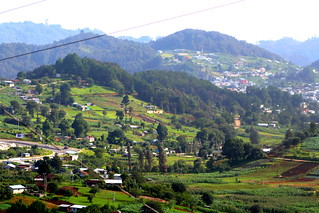 where some of the finest traditional hand weaving in all of Mexico is being created. And not only did we manage to visit with some master weavers, we also got the opportunity to experience some of the unique cultural traditions of these villages.
where some of the finest traditional hand weaving in all of Mexico is being created. And not only did we manage to visit with some master weavers, we also got the opportunity to experience some of the unique cultural traditions of these villages.
On the morning of our first full day in San Cristóbal, Guide Juan José Cruz picked us up at our hotel in his comfortable car and we headed northeast out of the city to the puebla of Tenejapa. It was a beautiful 45 minute drive through the countryside.
Tenejapa is a little too far from San Cristóbal de las Casas to be a part of the typical tourist circuit but the reputation of the weavers in this village made it a must see place for us.
A slight drizzle fell on this Saturday morning, as we entered the village. Juan José stopped at a house with a high perimeter wall and checked to see if the lady was at home. When he returned to the 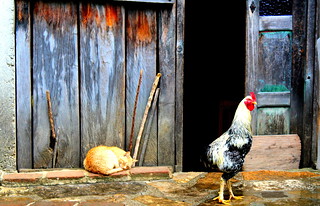 car he told us that because she usually weaves outside so (due to the rain) the lady was not weaving today and that she had just sent a load of her work to the Sna Jolobil weaving co-operative in the city so she didn’t have a lot of things to show us but if we wanted to talk, she would be happy to meet with us. After a little discussion we decided what the heck, we might as well. It was only after entering the compound (where we saw the rooster and cat in this photo) that we realized we were at the home of the famous master weaver María Meza Girón. If you Google María Meza Girón, you’ll find a long list of entries including this one: Every Woman Is a World: Interviews with Women of Chiapas; where she tells a very humble life story in an interview several years ago. Her declaration in the interview of “My work is good.” might be considered by some to be one of the great understatements of all time.
car he told us that because she usually weaves outside so (due to the rain) the lady was not weaving today and that she had just sent a load of her work to the Sna Jolobil weaving co-operative in the city so she didn’t have a lot of things to show us but if we wanted to talk, she would be happy to meet with us. After a little discussion we decided what the heck, we might as well. It was only after entering the compound (where we saw the rooster and cat in this photo) that we realized we were at the home of the famous master weaver María Meza Girón. If you Google María Meza Girón, you’ll find a long list of entries including this one: Every Woman Is a World: Interviews with Women of Chiapas; where she tells a very humble life story in an interview several years ago. Her declaration in the interview of “My work is good.” might be considered by some to be one of the great understatements of all time.
The short version of her s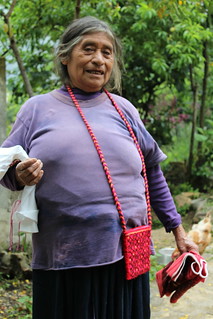 tory begins as a child of a single mother struggling to make ends meet. As a teenager, a cousin taught her to weave and over time; as her skill and confidence grew, she not only wove the traditional patterns, she had the self assurance to modify some of the iconic traditional symbols and create new designs.As her talents became recognized, her son Pedro Meza realized no one had ever made a record of the traditional or new designs so he began drawing them.
tory begins as a child of a single mother struggling to make ends meet. As a teenager, a cousin taught her to weave and over time; as her skill and confidence grew, she not only wove the traditional patterns, she had the self assurance to modify some of the iconic traditional symbols and create new designs.As her talents became recognized, her son Pedro Meza realized no one had ever made a record of the traditional or new designs so he began drawing them.
In the early 1970s, Chip Morris, an American studying the history of Mayan textiles in Chiapas became aware of the drawings and through contact with Pedro Meza he met María Meza Girón. Along with Chip Morris, the mother and son were co-founders of the Sna Jolobil cooperative in San Cristóbal where the women from the surrounding area can sell the best of their weaving. Today, Pedro not only leads that organization, but he is also mayor of Tenejapa.
We talked for a few minutes and she showed us some old things she had that hadn’t gone to the co-operative and then Juan José told her that my wife was a weaver and she seemed to open up to us. 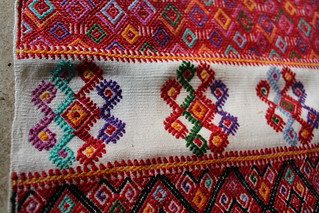 She took us inside to a room where she unrolled a very large piece she was working on. It was commissioned by a man that wanted a piece twice as long as the typical weaving and she said she had been working on it off and on for about a year. It was really one of the most impressive weavings we have ever seen anywhere.
She took us inside to a room where she unrolled a very large piece she was working on. It was commissioned by a man that wanted a piece twice as long as the typical weaving and she said she had been working on it off and on for about a year. It was really one of the most impressive weavings we have ever seen anywhere.
After our visit with María Meza Girón ended, we drove a half block towards the village center and arrived at the workshop of her niece, Maria  Meza Guzman who is a master weaver in her own right. In addition to creating her own works, Maria Meza Gusman has opened another weaving co-operative in Tenejapa as a local alternative to the more famous Sna Jolobil in San Cristóbal city for weavers seeking to sell their wares.
Meza Guzman who is a master weaver in her own right. In addition to creating her own works, Maria Meza Gusman has opened another weaving co-operative in Tenejapa as a local alternative to the more famous Sna Jolobil in San Cristóbal city for weavers seeking to sell their wares.
In 1993 as a young woman, Maria Meza Guzman toured the U.S. as the only weaver as a part of an exhibition promoting traditional Mayan weaving. She was incredibly friendly and really just fun to be around. She was working on a piece in the brocade style and very open to our questions about her techniques. While she preferred that we not take a full frame picture of her, she did allow us to take a picture of her hands.
It was only a few blocks from Maria Meza Guzman’s studio to the central square. On one side of the square is the small blue & white 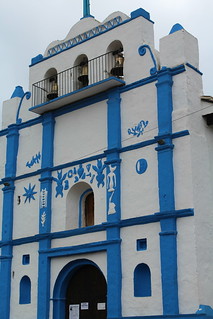 Catholic Church with Maya symbols painted on the façade. Being Saturday, there wasn’t much activity going on inside the church other than some cleanup and other preparations for the next day.
Catholic Church with Maya symbols painted on the façade. Being Saturday, there wasn’t much activity going on inside the church other than some cleanup and other preparations for the next day.
While inside the church, Juan José pointed out some examples of the co-mingling of the two cultures and explained to us how the Dominicans were the most successful of the Catholic orders in converting the indigenous people of Chiapas because they encouraged the blending of Catholic and Maya traditions while other orders attempted to completely replace the Maya traditions with new Catholic ones. From the Maya perspective, this fusion allowed them to see their own traditional symbols when they were looking at Catholic icons.
On the opposite side of the square was the municipal building where we saw 4
 policemen and city officials wearing the traditional white wooly top and necklace of coins sitting under the corridor our front of the building. (Sorry; no pictures allowed.)
policemen and city officials wearing the traditional white wooly top and necklace of coins sitting under the corridor our front of the building. (Sorry; no pictures allowed.)
On a portion of the wall was one of the murals in Tenejapa by Antun Kojtom Lam. The painting depicts the role of Women Weavers in Chiapas showing a woman connected to the earth, moon and sun, holding yarn that flows out to many of the symbols woven into local textiles. The mural also features weaving tools like spindles, warping mills and a back-strap loom.
While we were looking at the mural a couple local gentlemen obviously under the influence of too much of the local home brew known as Posh, asked for a donation.
After a great morning in Tenejapa, we returned to San Cristóbal de las Casas for lunch and an afternoon of visiting city sights.
